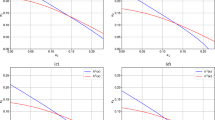Abstract
The paper shows how the mathematical tools of the theory of controlled Markov fields can be applied to model catastrophic risks caused by natural events or terrorist threats. The examples of problem statements of long-term investment in security are given. A survey of solution methods for stochastic optimal control problems is proposed. It is shown that these problems can be reduced to finite-dimensional stochastic programming problems and can be solved by the stochastic quasigradient method.
Similar content being viewed by others
References
C. D. Daykin, T. Pentikainen, and M. Pesonen, Practical Risk Theory for Actuaries, Chapman and Hall, London–New York (1993).
R. Kaas, M. Goovaerts, J. Dhaene, and M. Denuit, Modern Actuarial Risk Theory: Using R, Springer-Verlag, Berlin–Heidelberg (2008).
G. Walker, “Current developments in catastrophe modelling,” in: N. R. Britton and J. Oliver (eds.), Financial Risks Management for Natural Catastrophes, Griffith. Univ., Brisbane, Australia (1997), pp. 17–35.
A. Amendola et al. (eds.), “Integrated catastrophe risk modeling: Supporting policy processes,” Advances in Natural and Technological Hazards Research, 32, Springer, Dordrecht (2013).
Yu. M. Ermol’yev, T. Yu. Ermol’yeva, G. McDonald, and V. I. Norkin, “Problems on insurance of catastrophic risks,” Cybern. Syst. Analysis, 37, No. 2, 220–234 (2001).
Yu. M. Ermoliev, Stochastic Programming Methods [in Russian], Nauka, Moscow (1976).
Yu. Ermoliev and R. J.-B. Wets (eds.), Numerical Techniques for Stochastic Optimization, Springer Series in Computational Mathematics, 10, Springer-Verlag, Berlin (1988).
A. Ruszczyński and A. Shapiro (eds.), Stochastic Programming, Handbooks in OR & MS, Elsvier, Amsterdam (2003).
R. Bellman, Dynamic Programming, Dover Publ. (2003).
R. A. Howard, Dynamic Programming and Markov Processes, Technology Press and Wiley, New York–London (1960).
C. Derman, Finite State Markovian Decision Processes, Academic Press, New York–London (1970).
E. B. Dynkin and A. A. Yushkevich, Controlled Markov Processes and their Applications [in Russian], Nauka, Moscow (1975).
H. Mine and S. Osaki, Markovian Decision Processes, Elsevier Sci. Ltd. (1970).
I. I. Gikhman and A. V. Skorokhod, Controlled Random Processes [in Russian], Naukova Dumka, Kyiv (1977).
D. P. Bertsekas and S. E. Shreve, Stochastic Optimal Control: The Discrete-Time Case, Athena Scientific (2000).
A. B. Piunovskii, “Controlled random sequences: Methods of convex analysis and problems with functional constraints,” Uspekhi Mat. Nauk, 53, Issue 6, 129–192 (1998).
N. B. Vasil’ev and O. K. Kozlov, “Reversible Markov chains with local interaction,” in: Multicomponent Random Systems [in Russian], Nauka, Moscow (1978), pp. 83–100.
O. K. Kozlov and N.B. Vasilyev, “Reversible Markov chains with local interactions,” in: R. L. Dobrushin and Y. G. Sinai (eds.), Multicomponent Random Systems. Advances in Probability and Related Topics, 6, Marcel Dekker, New York, pp. 451–469 (1980).
M. B. Averintsev, “Description of Markov random fields with the help of the Gibbs conditional probabilities,” Probab. Theory and its Application, 17, No. 1, 21–35 (1972).
T. M. Ligett, Interacting Particle Systems, Springer, Berlin (1985).
T. M. Ligett, Stochastic Interacting Systems: Contact, Voter, and Exclusion Processes, Springer, Berlin (1999).
G. Daduna, P. S. Knopov, and R. K. Chornei, “Local control of Markovian processes of interaction on a graph with a compact set of states,” Cybern. Syst. Analysis, 37, No. 3, 348–360 (2001).
H. Daduna, P. S. Knopov, and R. K. Chornei, “Controlled semi-Markov fields with graph-structured compact state space,” Theory of Probability and Mathematical Statistics, 69, 39–53 (2004).
R. K. Chornei, H. Daduna, and P. S. Knopov, Control of Spatially Structured Random Processes and Fields with Applications, Springer, New York (2006).
R. K. Chornei, H. Daduna, and P. S. Knopov, “Controlled Markov fields with finite space on graphs,” Stochastic Models, 21, 847–874 (2005).
Y. Ermoliev, T. Ermolieva, and V. I. Norkin, “Economic growth under shocks: Path dependencies and stabilization,” H. Liljenstroem and U. Svedin (eds.), Micro-Meso-Macro: Addressing Complex Systems Couplings, World Scientific, London (2005), pp. 289–302.
V. I. Norkin, “Assessment of the risk of catastrophic decrease in stochastic models of economic growth,” in: Teoriya Optym. Rishen’, V. M. Glushkov Inst. of Cybernetics, NAS Ukr. (2007), pp. 41–50.
A. Manne, “Linear programming and sequential decisions,” Manage. Sci., 6, 259–267 (1960).
C. Derman, “Markovian sequential decision processes,” in: Stochastic Processes in Mathematical Physics and Engineering. Proc. of Symposia in Applied Mathematics, 16, AMS, Providence, 281–289 (1964).
Yu. M. Ermoliev and V. I. Norkin, “Solution of nonconvex nonsmooth stochastic optimization problems,” Cybern. Syst. Analysis, 39, No. 5, 701–715 (2003).
P. Brémaud, Markov Chains, Gibbs Fields, Monte Carlo Simulation, and Queues, Springer-Verlag, New York (1999).
Y. Ermoliev, A. Gaivoronski, and M. Makowski, “Robust design of networks under risks,” in: K. Marti et al. (eds.), Coping with Uncertainty. Lecture Notes in Economics and Mathematical Systems, 633, Springer-Verlag, Berlin–Heidelberg (2010), pp. 101–137.
D. M. Becker and A. A. Gaivoronski, “Stochastic optimization on social networks with application to service pricing,” Comput. Manag. Sci. (2013), pp. 1–32 (Published online, DOI 10.1007/s10287–013–0201–7).
H. K. Jevne, P. C. Haddow, and A. A. Gaivoronski, “Evolving constrained mean-VaR efficient frontiers,” Evolutionary Computation (CEC), WCCI 2012 IEEE World Congress on Computational Intelligence, Australia, Brisbane, IEEE (2012), pp. 1–8.
Author information
Authors and Affiliations
Additional information
1The study was financially supported by the grant of the Norwegian Centre for International Cooperation in Education (SIU), Norwegian–Ukrainian Project CPEALA-2012/10052.
Translated from Kibernetika i Sistemnyi Analiz, No. 1, January–February, 2015, pp. 97–110.
Rights and permissions
About this article
Cite this article
Haivoronskyy, O.O., Ermoliev, Y.M., Knopov, P.S. et al. Mathematical Modeling of Distributed Catastrophic and Terrorist Risks1 . Cybern Syst Anal 51, 85–95 (2015). https://doi.org/10.1007/s10559-015-9700-6
Received:
Published:
Issue Date:
DOI: https://doi.org/10.1007/s10559-015-9700-6




